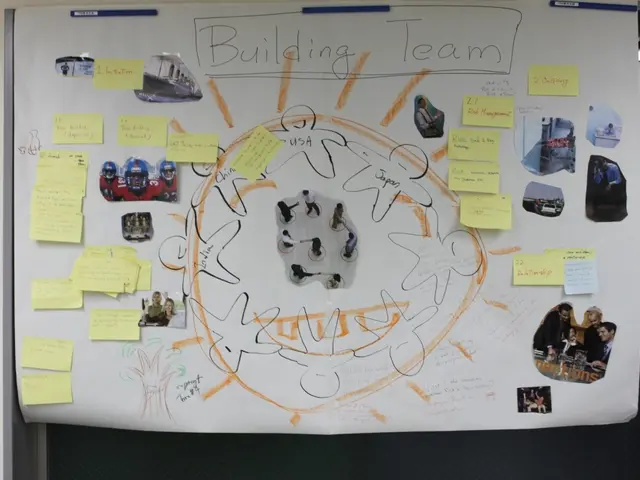Seven Effective Methods of Positive Discipline: Encouraging Over Criticizing, Incentivizing Rather Than Punishing
Parenting with love and patience involves using the right methods to guide your children, setting clear expectations, and encouraging them to learn from their mistakes. Effective communication and consistency are key aspects of this approach. Let's explore seven techniques that emphasize positive reinforcement and support your little ones on their journey to becoming responsible, self-disciplined individuals who form strong family bonds.
Offer Choices
Providing your child with choices empowers them, reduces power struggles, and fosters a sense of ownership. Offering a couple of acceptable options instead of giving a straight command can help minimize resistance.
Create a "Yes" Environment
Establish a "yes" environment by making your home a safe, fun, and supportive space where children can learn, explore, and experiment. A "yes" environment reduces stress for both children and parents, fostering positive behavior and independence.
Teach Emotional Intelligence
Helping your child understand and manage their emotions is an essential part of effective discipline. Teach them about different feelings, how to express them appropriately, and how to cope when their emotions become overwhelming.
Ignore Minor Misbehaviors
Sometimes it's best not to react to small misbehaviors, such as whining or rummaging through drewers. Ignoring these minor behaviors occasionally can help reduce attention-seeking behavior and create a more relaxed atmosphere at home.
Use Positive Timeouts
Timeouts can be a powerful positive discipline tool when used properly. Instead of serving as punishment, a timeout serves as a temporal separation between a child and the source of their frustration, helping them calm down and regain control of their emotions.
Natural and Logical Consequences
Let your child experience the natural consequences of their actions in safe and controlled situations. This approach encourages children to understand the relationship between their behavior and its results, promoting problem-solving and self-reflection.
Involve Children in Problem-Solving
Encourage your child to take an active role in solving problems with you. Involving your child in conflict resolution helps develop their self-control, critical thinking, and communication skills. By collaborating together, you strengthen the bond between you and your child, while simultaneously teaching them essential life skills.
By incorporating these techniques into your parenting approach, you encourage your child's development, build a strong family bond, and establish a harmonious home environment.
A Guided Approach
Positive discipline is all about teaching instead of punishing, helping your child grow and thrive. Setting clear rules, providing consequences that fit their age, and maintaining a caring and respectful relationship are key aspects of this method.
The Positive Discipline Parenting and Classroom Management Model can provide guidance in implementing positive discipline techniques. This approach prioritizes emotional intelligence, active learning, and collaborative problem-solving. Adopting a positive discipline philosophy can bring about positive change in your child's life and help strengthen your relationship with them.
The Importance of Positive Discipline
Positive discipline offers numerous benefits for both children and parents. It helps raise emotionally intelligent and self-assured kids who can solve problems, make decisions, and build strong relationships. Positive discipline also enhances the parent-child bond by fostering trust, cooperation, and understanding.
Positive Discipline Techniques
A variety of positive discipline techniques can help guide your child's behavior. These methods focus on positive reinforcement, empathy, and collaboration.
Offer Choices
Offering choices empowers your child and helps them develop a sense of autonomy. This technique reduces power struggles and helps children feel valued and respected.
Create a "Yes" Environment
Creating a "yes" environment encourages exploration, independence, and positive behavior. A "yes" environment emphasizes safety, fun, and emotional support, while minimizing the need for constant reprimands.
Teach Emotional Intelligence
Focusing on emotional intelligence helps your child understand their feelings and how to express them appropriately. As a result, they'll be less likely to act out and will develop stronger communication skills.
Ignore Minor Misbehaviors
Ignoring small misbehaviors can help reduce attention-seeking behavior, creating a more relaxed atmosphere at home. This technique should be used wisely and selectively.
Use Positive Timeouts
Positive timeouts help children calm down and regain control of their emotions. Instead of serving as punishment, positive timeouts can serve as an opportunity for reflection and self-regulation.
Natural and Logical Consequences
Allow your child to experience the natural consequences of their actions in safe and controlled situations. This technique encourages children to understand the relationship between behavior and its outcomes, promoting problem-solving and self-reflection.
Involve Children in Problem-Solving
Collaborate with your child to solve problems, giving them a sense of ownership and responsibility. Encouraging their active participation in conflict resolution helps develop essential life skills.
By incorporating these positive discipline methods, you create a supportive and empowering environment that encourages your child's emotional, social, and cognitive development.
Enrichment Data:
Effective Positive Discipline Techniques for Parents
Positive discipline is an approach that focuses on teaching children right from wrong by using supportive and encouraging methods. Here are some effective techniques parents can use:
1. Set Clear Expectations
- Use written rules or visual aids to reinforce expectations
- Frame rules positively, using examples like "In this family, we pack up our things before dinner" [5]
2. Use Positive Reinforcement
- Use descriptive praise to acknowledge good behavior, highlighting both the behavior and its benefits
- Reinforce good behavior with positive outcomes, like extending privileges for good behavior [4]
3. Be a Role Model
- Children often mimic their parents' behavior, so model the behavior you want to see in them
4. Redirection
- Move children from inappropriate to appropriate behavior, explaining why the original behavior was not acceptable
5. Logical Consequences
- Use consequences that fit the misbehavior
- Reinforce good behavior with positive outcomes
6. One-on-One Time
- Spend dedicated time with your child to strengthen your relationship and improve communication
7. Calm Consequences
- Stay calm and use gentle but firm consequences to teach responsibility without fear
These techniques help build a strong, supportive relationship with your child while teaching them important life skills and values.
- Incorporating emotional intelligence lessons into daily interactions helps children learn to manage their emotions appropriately and effectively.
- Offering choices empowers children, fosters a sense of ownership, and reduces resistance by providing a couple of acceptable options instead of giving a straight command.
- Adopting a "yes" environment creates a safe, fun, and supportive space where children can learn, explore, and experiment, reducing stress for both children and parents and fostering positive behavior and independence.
- Minimizing attention-seeking behavior and creating a more relaxed atmosphere at home can be achieved by ignoring minor misbehaviors such as whining or rummaging through drawers occasionally.
- Properly using timeouts as a positive discipline tool can help children calm down and regain control of their emotions, serving as a temporal separation between a child and the source of their frustration.
- Encouraging children to take an active role in solving problems with parents helps develop their self-control, critical thinking, and communication skills, strengthening the bond between parent and child.
- By adopting the positive discipline philosophy and the Positive Discipline Parenting and Classroom Management Model, parents can learn effective discipline strategies, emphasizing emotional intelligence, active learning, and collaborative problem-solving, resulting in positive changes in a child's life and a stronger parent-child relationship.
Positive discipline techniques include setting clear expectations, using positive reinforcement, being a role model, redirection, implementing logical consequences, spending dedicated one-on-one time with children, and using calm consequences to teach responsibility without fear.







